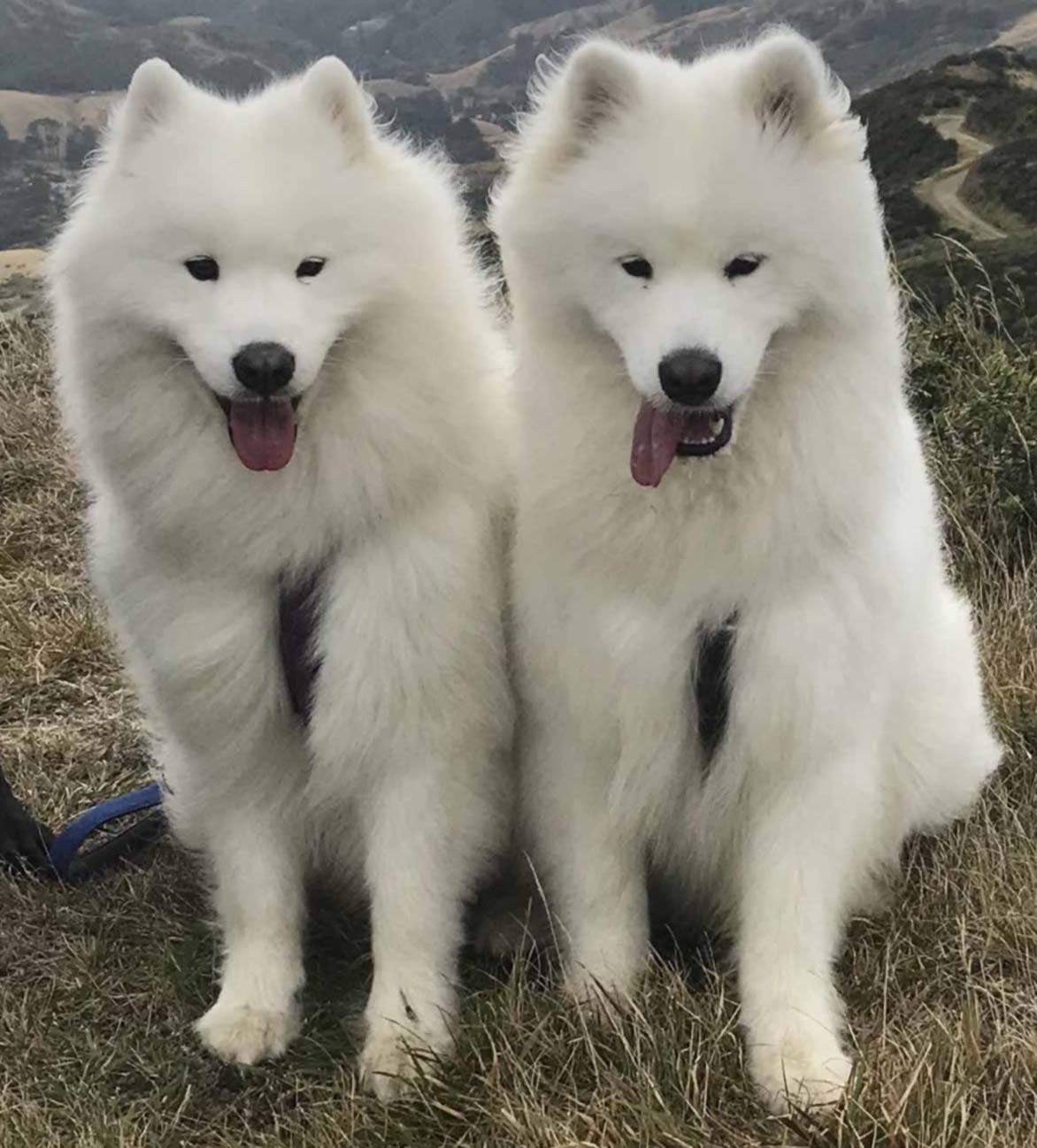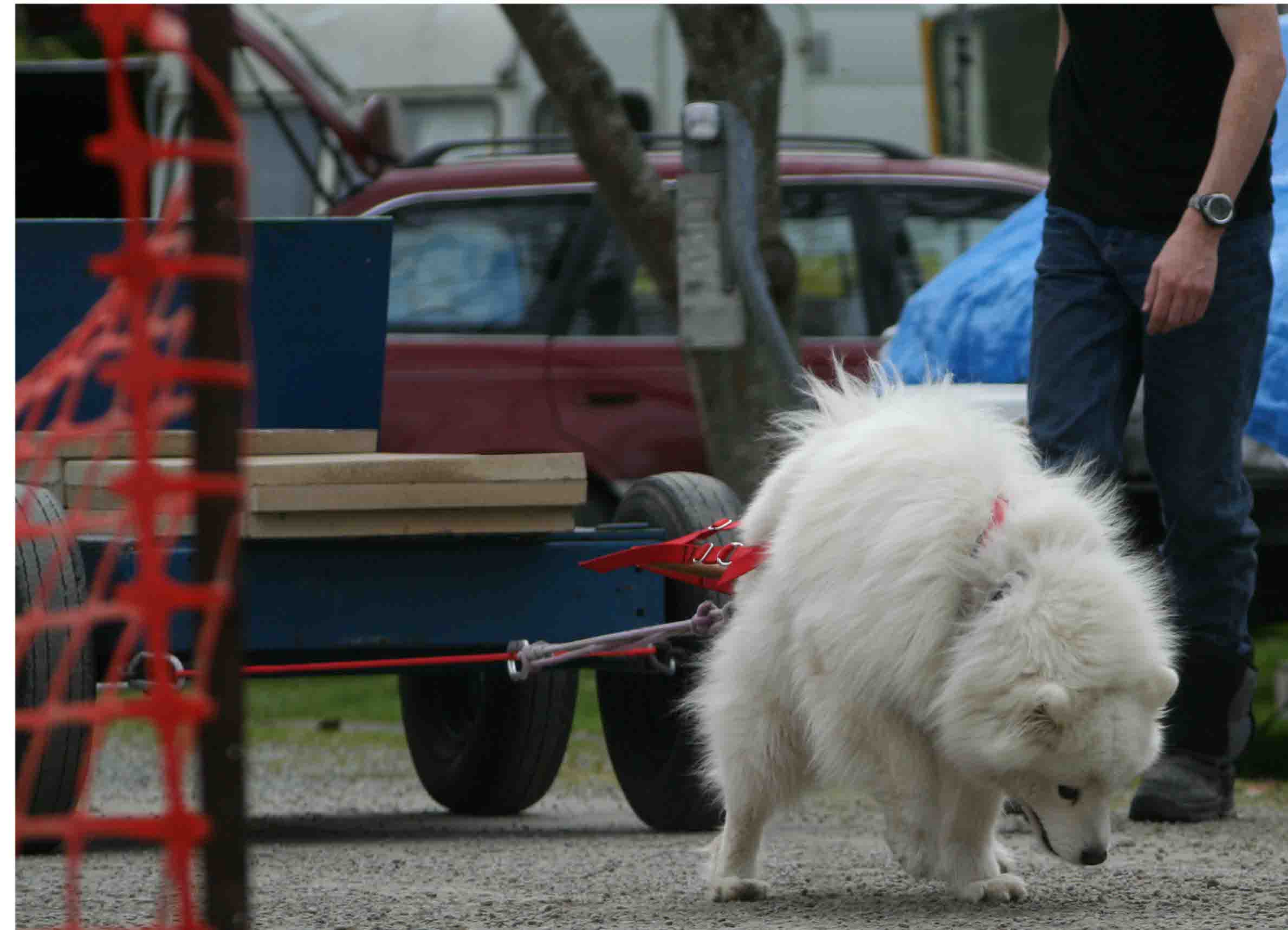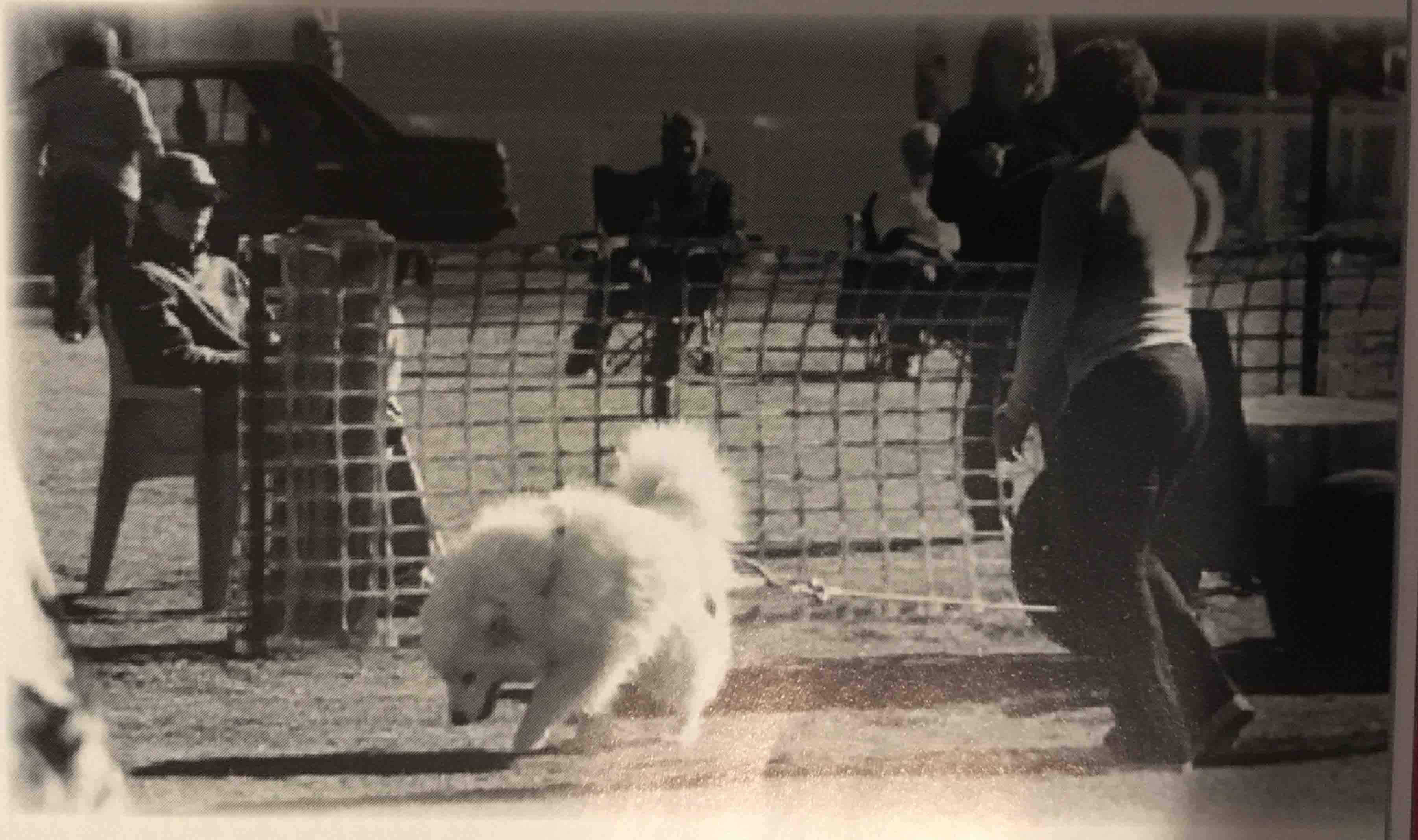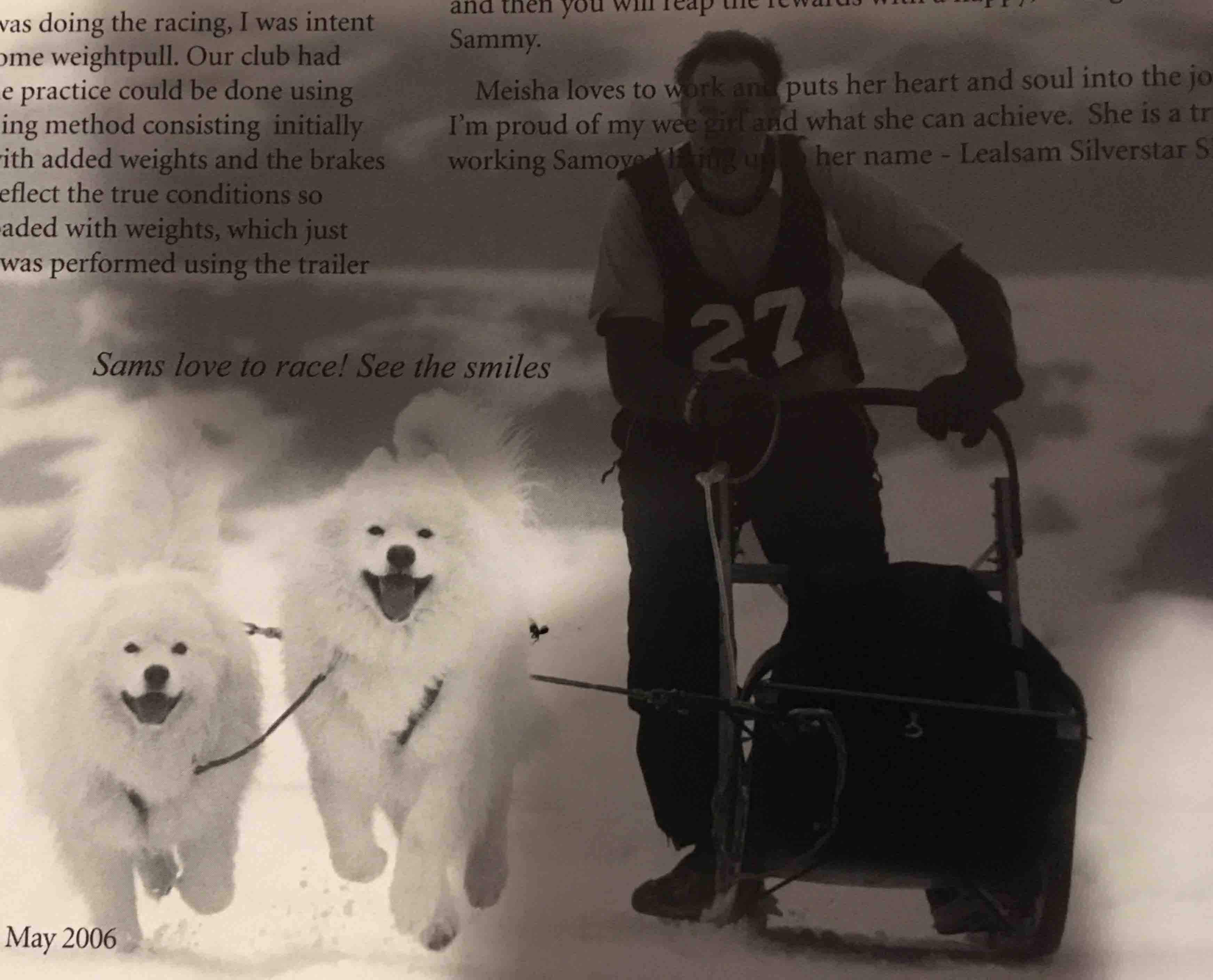For the betterment of the breed.

The Samoyed is an ancient breed originating from Russia and much admired for its beautiful white coat, smiling face, happy disposition and general good health.

THE SAMOYED IN WEIGHT PULL
Some of the sled dog clubs also provide weight pull competitions and a few Samoyeds have competed.
Sammys love to Pull! So Why not try Weightpull

What is Weightpull ?
Weightpull involves the dog pulling a wheeled cart/rig, loaded with added weights, about 5 metres along a flat surface. A special freight / weightpull harness is used which gives the dog comfort and safety and it has a special spreader bar in the back to help distribute the weight evenly (a racing harness is not suitable). The pull takes place within a chute while the handler calls the dog from in front of the chute. The dog has 45 seconds in which to pull the cart the marked 5 metres. The weights are increased after each round and you keep goining until the weight cannot be pulled ( or you pull out). The last successful pull is your dogs weight for the day.
There is a marshal in the chute that will hold your dog/sort out tangles if necessary. Also if there is a failed pull the marshal will usually "help" your dog out to complete the pull so that at the end the og is never allowed to finish with a failure (this is important as the dog is doing its best to please you).
There are 4 classes A - under 27kg; B - over 27kg - 36kg; C - over 36kg - 50kg; D - over 50kg.
The dogs must qualify before entering a competitive weightpull y pulling a minimum weight for their class - A - 113kg; B - 136kg; C - 158 kg; D - 181Kg:
Dogs can win in each division and there is also a prize for the body veight-ratio which is the total amount of weight pulled divided by the dogs weight (which can allow a Sammie to beat a Malamute!!) e.g. if a dog weighing 22kg pulls a top weight of 465kg its BWR is 21, beating a dog weighing 56 kg that pulls 600kg that has a BWR of 11.
As with sled dog racing the dogs can achieve titles based on points gained from competitions e.g. WP, WPX, WPCH
Full rules can be found on the NZ Federation of Sled Dog Sports website NZFSS.org.nz

by Debbie Langford,
The New Zealand Samoyed Supplement, NZ Kennel Gazette – May 2006
Sammys love to pull! So why not try Weightpull
Introducing Meisha - Lealsam Siverstar SD - the only Samoyed in New Zealand contesting competitive weightpull.
As most people with Samoyeds know they love to pull. So why not harness that energy into some fun activities? That is exactly where sled-dog sports fit into a Samoyed's life.
Into our second race season Meisha showed herself to be a white, fluffy powerhouse. So we decided to try some weightpull. The opportunity came at a sled-dog training weekend in Dunedin 2004, when everyone had the chance to put their dogs in weightpull harness and have a go! This is a special harness with spreader bar at the back to distribute weight evenly.
At the "have a go" session it became obvious that Meisha was having no trouble with weightpull, while our other Sam, Zak, just stood still and no amount of encouragement would get him to pull (even though pulling in racing was no problem). Meisha is reasonably good at obedience for a Sam
plus she is very food motivated. So the two things together meant that she was more than willing to come when called - even if it meant dragging that cart behind her!
After establishing that Meisha could do this, we began to think about competing. A qualifying weightpull was advertised as part of race meeting in 2004, so we went for it. This was our first real taste of competitive weightpull. The dogs enter in classes based on their weight.As Meisha is only little at 22kg, she was placed in class A (up to 27kg).
A practice was allowed with food first - then the competition started (no food is allowed in the chute or on your person during competition.) However Meisha easily pulled her qualifying weight. We went on to try a few more before pulling out reasonably early as we were still learning and I didn't want Meisha to be put off.
I then entered her in a competition in Hanmer where she did well, pulling 256 kg, coming in second in her class with a weight ratio of 12.31 (final weight pulled/body weight). This was just a chance to learn more for our training the following year. One thing I learnt was that it isn't necessary to attempt every pull, so you should skip some to rest dog if you know they can pull more.
So in 2005, while my husband was doing the racing, I was intent on getting my wee girl ready for some weightpull. Our club had purchased a weightpull rig so some practice could be done using this. We also devised a home-training method consisting initially of my husband on the racing rig with added weights and the brakes partly on. But this didn't seem to reflect the true conditions so then we used an old lawnmower loaded with weights, which just proved too easy. The final training was performed using the trailer with the front held up by the old lawnmower! So I was out in the driveway laden with saveloy treats with Meisha in her weightpull harness pulling the trailer. All I was getting her to do was to move the object a few metres toward me. I would crouch downlow, offer her the treat and call. You want the dog to go low at the front rather than bound upward, so my training was directed at getting the technique right, rather than the weight she was pulling.
Well it must have all paid off because Les took her to Taupo for the New Zealand Dryland Sled Dog Championships in July 2005 and also entered the weightpull. She came home with a lovely ribbon for first place in her class!
I then entered her in the weightpull at Hanmer in August, where much to the delight of the crowd cheering her on, she pulled 455kg. Again she came in first in her class and third in the body to weight ratio, with a value of 20.7. She then went on, an hour later, to race in single-dog freight carrying the musher plus and extra 35kg and placed second.
The spectators love her, this pretty little Samoyed giving her all. She loves to please - and gain her treats! And when the weight gets higher and harder to pull, sometimes the frustration shows and she barks as if to say: "I'm trying I'm trying" and I know she is. So when she can't do it any more and the
marshal helps her out to finish (so that the dog doesn't feel it's failed), I give her lots of hugs, kisses and treats and the crowd claps for her efforts.
We were introduced to Sled Dog Racing via Andy and Denise Reeve at a time when our 4 yr old male Samoyed Zak was bored with Obedience. He took to the racing with a passion, as if he had been waiting for this all his life. So it wasn't long before the next member of the team "Meisha" came along.
At present Meisha is the only Samoyed doing competitive weightpull in New Zealand. But I am sure that soon more will follow. Her racing and weightpull help to build and strengthen her muscles, ligaments and tendons and give her a good workout. I don't wish to push her beyond her capabilities, but she has exceeded all my expectations. So don't underestimate what your Samoyed can do. I believe that the couple of seasons racing before starting weightpull also helped build her strength and fitness. We now have another member of the team, Yogi Bear, who has the potential to be good at this sport also. But he is only young and I would not want to enter him for a year or so yet. He will begin a slow build up into racing this season. It is good to allow time for the dogs to mature and strengthen before freight or weightpull and then you will reap the rewards with a happy, strong working Sammy.
Meisha loves to work and puts her heart and soul into the job I'm proud of my wee girl and what she can achieve. She is a true working Samoyed living up to her name - Lealsam Silverstar SD.

Sams love to race! See the smiles
by Debbie Langford.
The New Zealand Samoyed Supplement, NZ Kennel Gazette – May 2006
